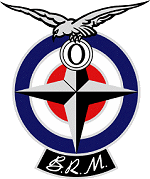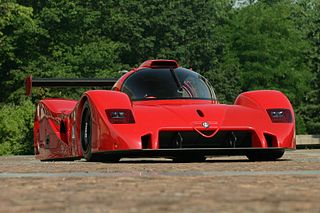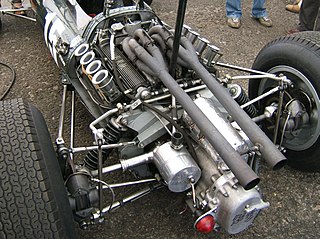
A flat-twelve engine, also known as a horizontally opposed-twelve, is a twelve-cylinder piston engine with six cylinders on each side of a central crankshaft.

The Cooper Car Company is a British car manufacturer founded in December 1947 by Charles Cooper and his son John Cooper. Together with John's boyhood friend, Eric Brandon, they began by building racing cars in Charles's small garage in Surbiton, Surrey, England, in 1946. Through the 1950s and early 1960s they reached motor racing's highest levels as their mid-engined, single-seat cars competed in both Formula One and the Indianapolis 500, and their Mini Cooper dominated rally racing. The Cooper name lives on in the Cooper versions of the Mini production cars that are built in England, but is now owned and marketed by BMW.

British Racing Motors (BRM) was a British Formula One motor racing team. Founded in 1945 and based in the market town of Bourne in Lincolnshire, it participated from 1951 to 1977, competing in 197 grands prix and winning seventeen. BRM won the constructors' title in 1962 when its driver Graham Hill became world champion. In 1963, 1964, 1965 and 1971, BRM came second in the constructors' competition.

Formula 5000 was an open wheel, single seater auto-racing formula that ran in different series in various regions around the world from 1968 to 1982. It was originally intended as a low-cost series aimed at open-wheel racing cars that no longer fit into any particular formula. The '5000' denomination comes from the maximum 5.0 litre engine capacity allowed in the cars, although many cars ran with smaller engines. Manufacturers included McLaren, Eagle, March, Lola, Lotus, Elfin, Matich and Chevron.

The Maserati 250F was a racing car made by Maserati of Italy used in '2.5 litre' Formula One racing between January 1954 and November 1960. Twenty-six examples were made.

The McLaren M7A and its M7B, M7C and M7D variants were Formula One racing cars, built by McLaren and used in the world championship between 1968 and 1971. After two relatively unsuccessful years of Formula One competition, the M7A was used to score McLaren's first win at the 1968 Belgian Grand Prix.

The Brabham BT19 is a Formula One racing car designed by Ron Tauranac for the British Brabham team. The BT19 competed in the 1966 and 1967 Formula One World Championships and was used by Australian driver Jack Brabham to win his third World Championship in 1966. The BT19, which Brabham referred to as his "Old Nail", was the first car bearing its driver's name to win a World Championship race.
Italian motor manufacturer Alfa Romeo has participated many times in Formula One. It currently participates as Alfa Romeo F1 Team Stake while being operated by Sauber Motorsport AG. The brand has competed in motor racing as both a constructor and engine supplier sporadically between 1950 and 1987, and later as a commercial partner since 2015. The company's works drivers won the first two World Drivers' Championships in the pre-war Alfetta: Nino Farina in 1950 and Juan Manuel Fangio in 1951. Following these successes, Alfa Romeo withdrew from Formula One.

The Cooper T81 is a Formula One car produced by the Cooper Car Company for the 1966 Formula One season. It represented something of a comeback for Cooper's fortunes, winning two races and enabling Cooper to finish third in the Constructors' Championship in 1966 and 1967.
The 1980 Australian Grand Prix was a motor race held at Calder Park Raceway in Victoria, Australia on 16 November 1980.

The BRM P261, also known as the BRM P61 Mark II, is a Formula One motor racing car, designed and built by the British Racing Motors team in Bourne, Lincolnshire, England. The BRM P261 was introduced for the 1964 Formula One season, and its design was an evolution of Tony Rudd's one-off BRM P61 car of 1963. The P261 had a relatively long racing career; variants of the car were still being entered for Formula One World Championship Grands Prix as late as 1968. During the course of their front-line career, BRM P261s won six World Championship races, in the hands of works drivers Graham Hill and Jackie Stewart, and finished second in both the Drivers' and Constructors' Championship standings in 1964 and 1965. Stewart, Hill and Richard Attwood also used works P261s to compete in the Tasman Series in 1966. The BRMs dominated, with Stewart winning four, Hill two, and Attwood one of the 1966 Tasman Series' eight races. Stewart also won the title. The works-backed Reg Parnell Racing team returned in 1967 with Stewart and Attwood, where Stewart added another two wins to his tally. In terms of races won and total championship points scored, the P261 was the most successful car in BRM's history.

Ecurie Bonnier, Ecurie Suisse, Joakim Bonnier Racing Team and Anglo-Suisse Racing Team were names used by Swedish racing driver Joakim Bonnier to enter his own cars in Formula One, Formula Two and sports car racing between 1957 and his death in 1972. Commonly the vehicles were entered for Bonnier himself, but he also provided cars for a number of other drivers during the period.
The Mildren name was used on a series of racing vehicles constructed for, or acquired by, Australian racing team owner Alec Mildren during the 1960s and early 1970s.

The BRM P83 was a Formula One racing car designed by Tony Rudd and Geoff Johnson and built by British Racing Motors for the new engine regulations of 1966. It used a highly unorthodox H16 engine which caused problems throughout the car's racing life, and despite the best efforts of Graham Hill and Jackie Stewart took BRM from championship contenders to also-rans, leading it to be regarded alongside the BRM Type 15 as another embarrassing failure for the British marque caused by overcomplicated engineering.
Colin Crabbe Racing, also known as Colin Crabbe - Antique Automobiles and Antique Automobiles Racing Team, was a privateer team run by Colin Crabbe, a noted dealer in historic racing cars, that entered a single car in 17 Formula One races in 1969 and 1970. Vic Elford and Ronnie Peterson drove for the team, the cars used being a Cooper T86, a McLaren M7B and a March 701.

The Alfa Romeo SE 048SP was a Group C racing car built by Alfa Romeo in the early 1990s. Designed to replace the Lancia LC2 after the Group C regulations had undergone a major revamp, the SE 048SP had an Abarth-developed chassis mated to the 3.5-litre V10 engine from the stillborn Alfa Romeo 164 Procar, but, although at least one SE 048SP was built, it never left the development phase. The V10 engine appears to have been replaced by a Ferrari-sourced 3.5-litre V12 engine at some point during its development, although this was never officially confirmed by Alfa Romeo.
Maserati made four naturally-aspirated, V12 racing engines, designed for Formula One; between 1951 and 1969. The first was an experimental O.S.C.A. engine; in accordance with the 4.5 L engine regulations imposed by the FIA for 1951. Their second engine was 250 F1 V12; in accordance with the 2.5 L engine regulations set by the FIA. Their last two V12 engines were customer engines supplied to Cooper; between 1966 and 1969. The Tipo 9 / F1 and Tipo 10 /F1, which were both manufactured to the FIA's 3.0 L engine regulations for 1966. One sports car, a modified version of the Maserati 350S, also used V12 engine, with a 3.5 L (210 cu in) displacement, and produced 335 hp (250 kW).
The Weslake V12 engine family is a series of four-stroke, 60-degree, naturally-aspirated, V-12 racing engine, designed, developed and produced by Weslake; between 1966 and 1992.

The British Racing Motors V8 was a four-stroke, naturally aspirated, 1.5 L (92 cu in), V-8 racing engine, designed, developed and built by British Racing Motors (BRM) to compete in Formula One racing (although an enlarged 2.0 L version was used for sports car racing. It was built between 1962 and 1967, and came in two version; the P56, and the P60.
The Cooper T80 was a Formula One racing car designed for the stillborn Climax FWMW 1.5 litre flat-16 engine. It was later converted to take a Maserati V12 as a test mule pending the arrival of the Cooper T81 chassis.













